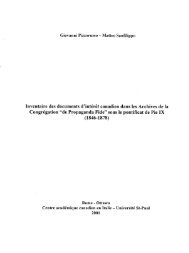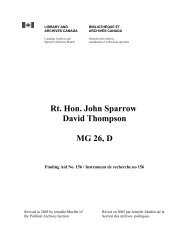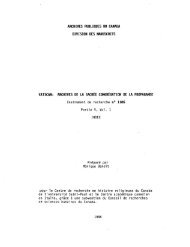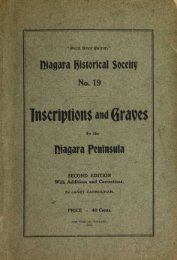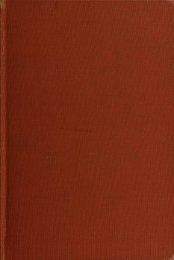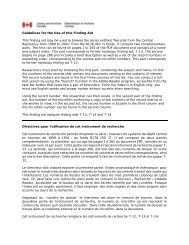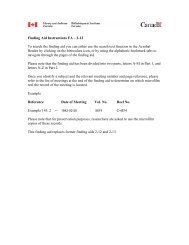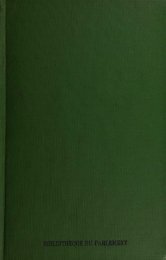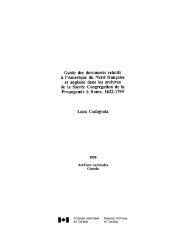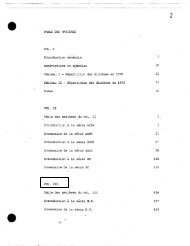Guide to Documents Relating to French and British North America in ...
Guide to Documents Relating to French and British North America in ...
Guide to Documents Relating to French and British North America in ...
Create successful ePaper yourself
Turn your PDF publications into a flip-book with our unique Google optimized e-Paper software.
VI. METHODS EMPLOYED IN THE PREPARATION OF THE<br />
CALENDAR<br />
The Calendar conta<strong>in</strong>s descriptions of 2,441 documents conserved <strong>in</strong> different series of the<br />
Propag<strong>and</strong>a Fide archives. 1 In all, 1,932 archival volumes were exam<strong>in</strong>ed. 2 Entries summarize the<br />
content of all the documents with respect <strong>to</strong> facts <strong>and</strong> <strong>in</strong>dividuals <strong>in</strong> <strong>French</strong> <strong>and</strong> <strong>British</strong> <strong>North</strong> <strong>America</strong><br />
between 1622 <strong>and</strong> 1799. We will now discuss the geographical <strong>and</strong> chronological scope of the<br />
Calendar.<br />
As <strong>to</strong> geography, s<strong>in</strong>ce there is no practical dist<strong>in</strong>ction <strong>in</strong> <strong>North</strong> <strong>America</strong> between <strong>French</strong> <strong>and</strong><br />
<strong>British</strong> terri<strong>to</strong>ries until the second half of the eighteenth century, both are accounted for. This edi<strong>to</strong>r<br />
has then <strong>in</strong>cluded the whole of what is now Canada, the eastern part of what is now the United States,<br />
particularly Louisiana, the area then called Ohio <strong>and</strong> Mississippi, <strong>and</strong> the great <strong>America</strong>n West, at that<br />
period almost exclusively <strong>in</strong> the h<strong>and</strong>s of the <strong>French</strong>. Conversely, documents deal<strong>in</strong>g with the area of<br />
the United States that from 1622 <strong>to</strong> 1799 was under Spanish rule are omitted, s<strong>in</strong>ce they were treated<br />
by the Holy See as the northernmost portion of South <strong>and</strong> Central (Le., Spanish) <strong>America</strong>. Florida as<br />
such was then excluded from the Calendar. 3 Louisiana was <strong>in</strong>cluded because, for the whole of the<br />
period <strong>in</strong> question, it presented someth<strong>in</strong>g of a political anomaly.<br />
Chronologically speak<strong>in</strong>g, 1622 is the only logical start<strong>in</strong>g po<strong>in</strong>t, s<strong>in</strong>ce it was the year <strong>in</strong> which<br />
Propag<strong>and</strong>a was established. On the other h<strong>and</strong>, 1799 represents quite simply the end of the eighteenth<br />
century, <strong>and</strong> the beg<strong>in</strong>n<strong>in</strong>g of another era for the Catholic church <strong>in</strong> Europe, which orig<strong>in</strong>ated from the<br />
disruption of the Napoleonic period. 4<br />
All documents of <strong>in</strong>terest <strong>to</strong> <strong>North</strong> <strong>America</strong> that pre-date 1622 were calendared; they were very<br />
few.s Conversely, a large number of documents were found that are dated after 1800. With very few<br />
exceptions,6 they were not <strong>in</strong>ven<strong>to</strong>ried <strong>and</strong> were left for a new calendar devoted <strong>to</strong> the period 1800<br />
<strong>and</strong> after. When the same archival volume was found <strong>to</strong> conta<strong>in</strong> documents dated 1799 <strong>and</strong> before, or<br />
1800 <strong>and</strong> after, only the former were calendared.<br />
This edi<strong>to</strong>r has tried <strong>to</strong> give the widest possible scope <strong>to</strong> his work, <strong>and</strong> <strong>to</strong> bear <strong>in</strong> m<strong>in</strong>d the many<br />
facets of the research <strong>and</strong> the variety of uses <strong>to</strong> which it might be put. He has therefore not restricted<br />
himself only <strong>to</strong> those documents mention<strong>in</strong>g <strong>North</strong> <strong>America</strong> (however briefly) or hav<strong>in</strong>g a direct bear<strong>in</strong>g<br />
on the his<strong>to</strong>ry of <strong>North</strong> <strong>America</strong>, but has also taken <strong>in</strong><strong>to</strong> consideration documents that do not refer<br />
specifically <strong>to</strong> <strong>America</strong>. His view encompasses those that may have <strong>in</strong> some way <strong>in</strong>fluenced the<br />
<strong>America</strong>n policy of Propag<strong>and</strong>a (for example, the many documents regard<strong>in</strong>g the Capuch<strong>in</strong>s <strong>in</strong> the first<br />
half of the seventeenth century), which <strong>in</strong>dicate the depth of knowledge of <strong>America</strong>n affairs on the part<br />
of Propag<strong>and</strong>a officials (for example, the different subdivisions of the world among the various<br />
card<strong>in</strong>als of Propag<strong>and</strong>a, where <strong>North</strong> <strong>America</strong> was notably absent), <strong>and</strong> that demonstrate the possibility<br />
of errors <strong>and</strong> mistaken geographical attributions (for example, the confusion between <strong>America</strong> <strong>and</strong><br />
Africa, the West Indies <strong>and</strong> the East Indies, Armenia <strong>and</strong> <strong>America</strong>, Newfoundl<strong>and</strong> <strong>and</strong> the Holy<br />
L<strong>and</strong>).'<br />
Obviously there can be no objective limit <strong>to</strong> research, unless we undertake an analysis of the<br />
entire body of Propag<strong>and</strong>a's documentation. For example, the problems aris<strong>in</strong>g between the Jesuits <strong>and</strong><br />
Propag<strong>and</strong>a <strong>in</strong> Ch<strong>in</strong>a had, <strong>in</strong> their tum, a decided <strong>in</strong>fluence upon the relations between the Jesuits <strong>and</strong><br />
Propag<strong>and</strong>a <strong>in</strong> <strong>North</strong> <strong>America</strong>. Noth<strong>in</strong>g is, ultimately, beyond the scope of this enquiry. As no such<br />
objective criterion can exist, <strong>and</strong> such an extension is clearly impracticable, the f<strong>in</strong>al choice <strong>and</strong><br />
responsibility must lie with the edi<strong>to</strong>r. Any error should, however, be on the side of excess, <strong>and</strong> any<br />
omission must be put down <strong>to</strong> the mistakes <strong>to</strong> which any archival research is open.<br />
69




